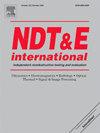Measurement of oxide film thickness for coated fuel rod cladding using swept-frequency ECT and parameters separation
IF 4.1
2区 材料科学
Q1 MATERIALS SCIENCE, CHARACTERIZATION & TESTING
引用次数: 0
Abstract
The fuel rod cladding serves as the first safety barrier within a nuclear power plant. It is essential to measure and evaluate the thickness of oxide film on the fuel rod cladding with micrometer level precision to ensure the operation safety of the nuclear power plant. In recent years, fuel rods with metal coating are utilized to enhance the mechanic characteristics of the rods, resulting in further challenge for the measurement. This paper presents a novel swept-frequency eddy current testing (ECT) method for the oxide film thickness measurement, which suppresses the interference of the coating parameters by a multi-parameter separation algorithm. A finite element method model is established to study the effect of the conductivity of the cladding and thickness of the coating on the oxide film thickness measurement. Then, a multi-parameter separation algorithm is developed to process the simulation data. It is demonstrated that the calculation error of the algorithm is less than 0.4 μm with varying material parameters. In addition, a prototype probe is developed and tested. The experimental results show that with different thicknesses of metal coatings, the proposed method can measure the oxide film thickness on fuel rod cladding with error less than 3 μm, which can satisfy the field application.
求助全文
约1分钟内获得全文
求助全文
来源期刊

Ndt & E International
工程技术-材料科学:表征与测试
CiteScore
7.20
自引率
9.50%
发文量
121
审稿时长
55 days
期刊介绍:
NDT&E international publishes peer-reviewed results of original research and development in all categories of the fields of nondestructive testing and evaluation including ultrasonics, electromagnetics, radiography, optical and thermal methods. In addition to traditional NDE topics, the emerging technology area of inspection of civil structures and materials is also emphasized. The journal publishes original papers on research and development of new inspection techniques and methods, as well as on novel and innovative applications of established methods. Papers on NDE sensors and their applications both for inspection and process control, as well as papers describing novel NDE systems for structural health monitoring and their performance in industrial settings are also considered. Other regular features include international news, new equipment and a calendar of forthcoming worldwide meetings. This journal is listed in Current Contents.
 求助内容:
求助内容: 应助结果提醒方式:
应助结果提醒方式:


